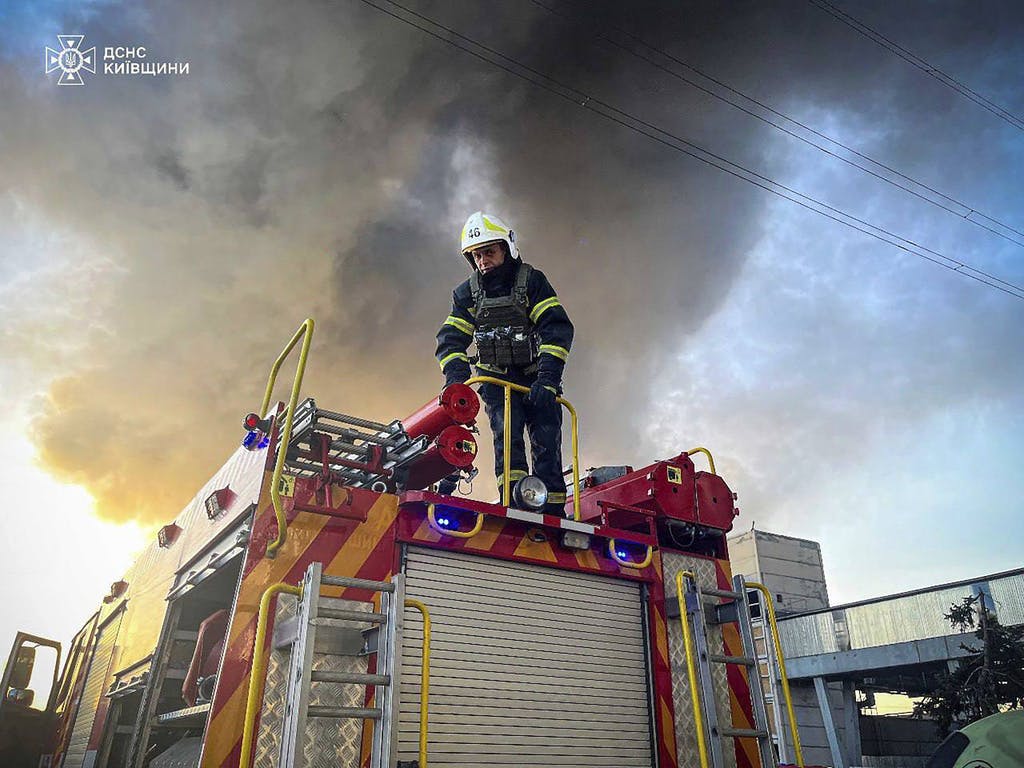Ukraine, With Capital’s Largest Power Plant Destroyed by Russian Bombardment, Laments Double Standard on West’s Missile Defense for Israel
Neither Israel nor Ukraine is a NATO member.

The clean sweep of 320 Iranian drones and missiles from Israeli skies last weekend grated on Ukrainians. Only last Thursday, they ran out of missile interceptors and saw their capital’s largest power plant destroyed.
“There were 11 missiles flying,” President Zelensky told PBS Monday of Russia’s April 11 attack on Trypillia, a 1,800 megawatt plant. “We destroyed the first seven, and four destroyed Trypillia. Why? Because there were zero missiles. We ran out of missiles to defend Trypillia.”
With Ukraine’s cupboard increasingly bare, Russia shows no signs of easing up on its campaign to knock out power plants and make Ukraine’s cities unliveable. Over the last two months, Russian missiles have destroyed 7 gigawatts of Ukrainian power generating capacity, including the nation’s largest hydroelectric project, in Zaporizhzhya. This missile campaign is seen as a warmup to an expected Russian summer land offensive.
“We see that, when allies act as one in a very coordinated way, not a single missile reaches targets in Israel,” Foreign Minister Dmytro Kuleba said Monday at a press conference in Kyiv. “All we are asking from partners, even if you cannot act the way you act in Israel, give us what we need and we will do the rest of the job.”
Mr. Zelensky says Ukraine needs 26 Patriot systems to defend its cities. However, only one is on its way, from Germany. In Washington, the House of Representatives has not approved new military aid since October. Today, legislative language is to be made public for bills extending aid to Ukraine, Israel and Taiwan. Potentially, they could be voted on next week and then sent to the Senate for approval.
Polls indicate that a majority of Americans support sending military aid to Ukraine. Straw polls indicate that a majority of House members favor the $60 billion aid package. However, President Trump does not. His ally, Speaker Johnson, has used various parliamentary stratagems to prevent a House vote since the Senate approved Ukraine aid two months ago.
Poland’s foreign minister, Radek Sikorski, called on X for America “to strengthen Israel’s anti-missile defense and equip Ukraine with similar systems.” He added: “The easiest way is to unlock the aid package for Ukraine and Israel.”
Mr. Zelenskiy and other Ukrainians note that neither Ukraine nor Israel is a NATO country. Yet, last weekend, America, Britain, France, and Jordan rallied around Israel to share information and to shoot down incoming missiles.
“Israel is not a NATO country,” the Ukrainian president told PBS. “The NATO allies, including NATO countries, have been defending Israel. They showed the Iranian forces that Israel was not alone. And this is a lesson.”
Analysts point out several differences. American support for Israel goes back decades and is supported by a very effective lobbying group. Since World War II, Israel is the largest cumulative recipient of American foreign aid, according to the Congressional Research Service.
“Different conflicts, different airspace, different threat picture,” the National Security Council spokesman, John Kirby, told reporters Monday. The missiles targeting Israel came largely from Iran, a non-nuclear regional power. The missiles targeting Ukraine come from Russia, a nation with 5,580 nuclear warheads.
“If you want to avoid an escalation in terms of a wider European war, I think the one thing you do need to avoid is NATO troops directly engaging Russian troops,” the British foreign secretary, David Cameron, told Britain’s LBC radio station on Monday. “That would be a danger of escalation.”
Advocates of direct American and British involvement in defending Ukraine point out that foreign pilots shot down Iranian missiles last weekend, but did not engage Iranian pilots. In Ukraine, this fear of NATO forces coming into direct contact with Russian forces stymied Ukrainian efforts to get the West to enforce a no-fly zone over Ukraine.
However, the battle lines are clearly drawn — between Ukraine and the West, and Russian and Iran. Mr. Zelensky said in his Sunday night speech to the nation: “Over the last week, Russian terrorists used nearly 130 Iranian suicide drones against Ukraine. They were followed by more than 80 Russian missiles and nearly 700 guided aerial bombs.”
Israel’s ambassador to Moscow, Simona Halperin, told Russia’s RIA news agency that Israel expects the Kremlin to condemn the Iranian attacks. A Russian foreign ministry spokeswoman, Maria Zakharova, shot back: “Remind me when Israel condemned at least one strike by the Kyiv regime on Russian regions? You don’t remember? Neither do I. But I do remember Israel’s regular statements in support of Zelensky’s action.”
With American aid uncertain, Ukrainian parliamentarian Andrii Osadchuk proposed on Facebook: “If suddenly the air forces of NATO countries want to shoot down Iranian drones in the sky of Israel more effectively, they can train for free in Ukraine.”

